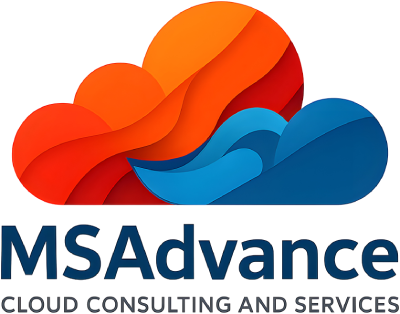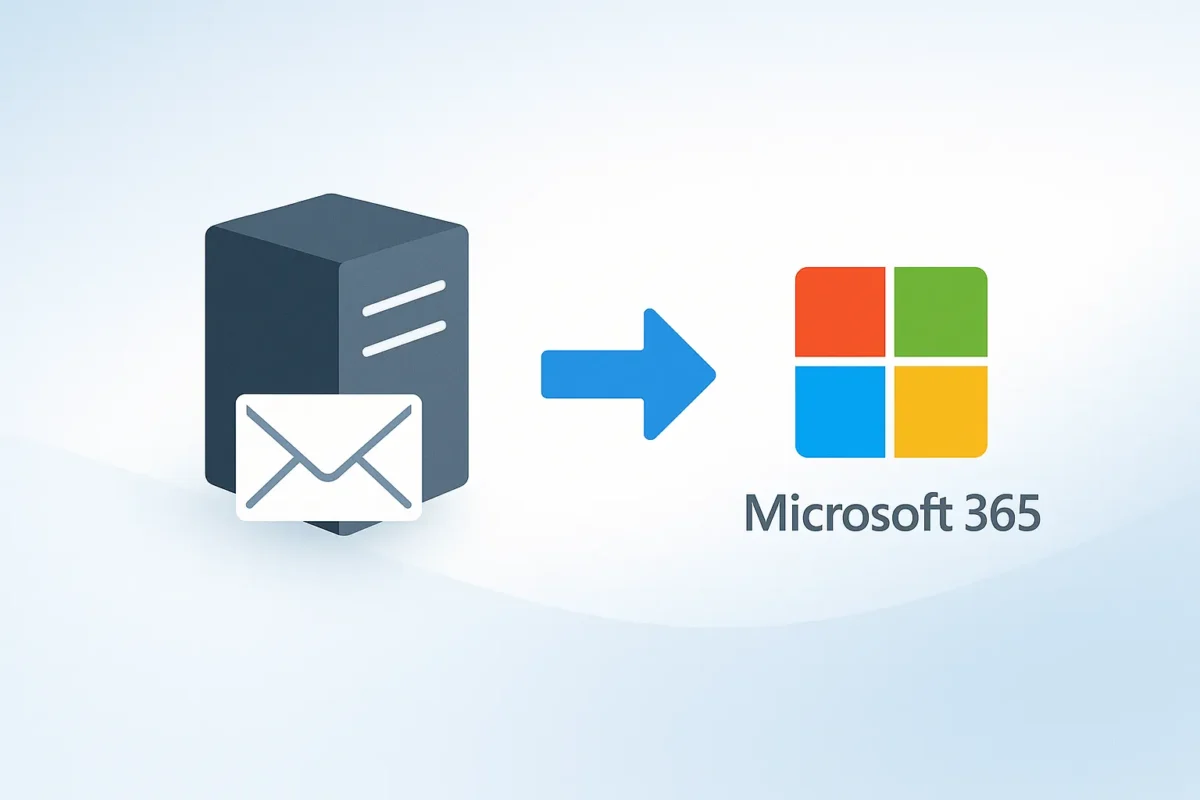Entra ID / Azure AD Migration (2025): end-to-end strategy — sync, federation, tenant-to-tenant, apps, security, and zero trust
This expanded guide helps you plan and execute a Microsoft Entra ID (Azure AD) migration with a practical, no-nonsense approach. You’ll find key decisions on hybrid synchronization (Cloud Sync vs Connect), federation → cloud authentication with staged rollout, tenant-to-tenant consolidation, applications and workload identities, External ID (B2B/Direct Connect), devices/Intune, governance (Access Reviews, Lifecycle Workflows), authentication methods (passkeys/FIDO2 in the Authentication Methods Policy), security (Conditional Access, Identity Protection), network & performance, EU Data Boundary, KPIs, and ready-to-use templates.
Entra ID migration with metrics, lower risk, and more value
MSAdvance combines architecture, automation, and governance so your identity works on day one—no loose ends.
1) Entra ID / Azure AD migration: context, zero trust, and when it’s worth it
Identity is a key pillar in any company. Migrating Entra ID isn’t moving users from one list to another—it’s redesigning how people and apps authenticate, authorize, and are audited in a zero trust model. A solid migration simplifies user experience, reduces on-prem dependencies, and lays the groundwork for modern auth (passkeys/FIDO2) and ongoing governance.
- When it makes sense: mergers or divestitures, tenant consolidation, retiring AD FS/STS, modernizing MFA/SSPR, complex multi-forest, security standardization across subsidiaries.
- Expected benefits: fewer access incidents, fewer unnecessary prompts, smaller attack surface, clear audit trail, and better adoption of M365/Azure/Teams.
- What’s in scope: synchronization, authentication, applications, devices, policies, network, operations, and compliance.
2) Discovery & assessment: domains, UPN, apps, risks, and licensing
Before choosing the path, know the terrain. Discovery prevents surprises, reduces rework, and speeds up decisions. It’s where migrations are won or lost.
2.1 Identity inventory
- Domains: verified/default, UPN suffixes, SIP/Teams, and legacy aliases; cleanup & verification plan.
- Source of authority: AD DS, HRIS, SCIM, manual joins; JML (joiner/mover/leaver) rules and identity matching.
- Roles & groups: clear owners, admin groups, PIM (JIT activation), and separation of duties.
2.2 Applications and dependencies
- Mapping: protocol (SAML/OIDC/WS-Fed), endpoints, certificates, reply URLs, and app-specific claims.
- Graph permissions: distinguish delegated vs application; find dependencies on legacy APIs (Azure AD Graph, basic EWS).
- Workload identities: Service Principals and Managed Identities used by automations/DevOps, and where they live.
2.3 Risk & compliance
- Conditional Access: policy inventory, “temporary” exclusions that linger for years, trusted locations, named locations.
- Legacy protocols: POP/IMAP/basic EWS, SMTP Auth; decide blocks and temporary exceptions with an end date.
- Residency/privacy: EU, sectoral, and contractual requirements (see EU Data Boundary).
2.4 Licensing & cost
- Entra ID P1/P2: CA, Identity Protection, Access Reviews, and Lifecycle Workflows.
- External ID: B2B/Direct Connect; model consumption if you have large-scale collaboration.
- Intune/Defender/Sentinel: if you’ll include device management, advanced protection, and observability with KQL.
3) Project plan: governance, pilots, waves, communications, and KPIs
A solid plan reduces day-zero stress. Define who decides, what gets tested, how dependencies are cut, and how progress is measured. Less improvisation, more predictability.
3.1 Governance & RACI
| Activity | R | A | C | I |
|---|---|---|---|---|
| Identity architecture | Identity Lead | CIO/CISO | SecOps, Networking | Support |
| Applications (SAML/OIDC) | App Owner | Architecture | Security | Key users |
| Conditional Access | SecOps | CISO | Identity | Support |
| Communications | Change/Comms | PM | Identity | All |
3.2 Pilot (2–4 weeks)
- Include “hard” profiles: VDI, travelers, sites with latency, legacy apps, and influential users.
- Useful metrics: sign-in success rate, MFA prompts per day, SSO success, latency, tickets per 100 users, critical apps OK.
- Define exit criteria: if unmet, tune before scaling.
3.3 Waves & schedule
- Homogeneous waves by unit/region for predictable support.
- Off-peak windows; avoid parallel changes (ERP, DNS, network).
- Per-wave criteria: success > 98%, controlled prompts, CA without blocks, apps validated, documented reversibility.
3.4 “Short & clear” comms
- T-7: what changes, why, and benefits (fewer passwords, more security).
- T-1: first steps (register passkey/Authenticator), timings, and support.
- T0: portal access, “what to do if…”, help channel in Teams/Service Desk.
- T+7: modern habits (passwordless, link sharing, co-authoring).
3.5 KPIs
- Time to first productive access (minutes).
- MFA prompts per user/day (should drop once CA stabilizes).
- % of sessions with SSO and % of passwordless sessions.
- Tickets at T0/T+7/T+30 and mean time to resolution.
4) Entra ID hybrid sync: Cloud Sync vs Connect (comparison and decision)
Sync is the bolt holding everything else together. Choose the engine that simplifies ops without losing what you need: writebacks, advanced rules, or hybrid Exchange.
4.1 Key differences
- Connect Sync: on-prem server with database and rules; supports password/device writeback and complex scenarios.
- Cloud Sync: lightweight agents; orchestration in Entra. Simple HA, disconnected multi-forest, fast cycles, and fewer servers.
4.2 Needle-movers
- Group writeback: write security groups from cloud to AD with Cloud Sync.
- Current recommendation: favor Cloud Sync if you don’t rely on device writeback or very specific customizations.
4.3 When to use each
| Option | Advantages | Limitations | Use it if… |
|---|---|---|---|
| Cloud Sync | Lightweight agents, agile HA, multi-forest, less maintenance | No device writeback | You want simpler ops and faster cycles |
| Connect Sync | Password/device writeback, hybrid Exchange, advanced rules | More on-prem complexity | You need writeback and deep customizations |
5) From AD FS to the cloud: staged rollout step by step with zero downtime
Moving from federation to cloud auth reduces complexity, improves resilience, and enables modern auth (passkeys/FIDO2, TAP, cloud CBA). With staged rollout you can pilot, expand by groups, and cut over without shocks.
5.1 Execution strategy
- Preparation: enable PHS or PTA + Seamless SSO; verify sync cycles and test sign-ins.
- Group pilot: enable staged rollout for representative cohorts; validate SSO, Outlook/Teams, and SAML/OIDC apps (certs and claims).
- Final cutover: convert the federated domain to managed in a controlled window; define rollback and validation checklist.
5.2 Limitations & red flags
- Basic POP/IMAP protocols and very old clients that don’t support modern flows.
- Non-persistent VDI without PRT; you may need temporary CA exceptions.
- Integrations with rigid federation assumptions; review endpoints and claims.
Cutover runbook (summary)
- Freeze changes in AD FS and synchronization.
- Backup domain and records configuration.
- Convert domain → managed; wait for propagation (~60 min).
- Validate sign-in, CA, SAML/OIDC apps, and clients (Outlook/Teams).
6) Tenant-to-tenant and multitenant migration: cross-tenant sync and Direct Connect
M&A, carve-outs, and multinational groups require identity that spans tenants without duplicating people. Goal: smooth collaboration with central control and clear rules.
6.1 Operating models
- Full consolidation: everything converges into a “hub” tenant.
- Governed multitenant: each company keeps its tenant but collaborates under shared rules (B2B + Direct Connect).
6.2 Cross-tenant synchronization
- Provision B2B users automatically in the target tenant with filtered attributes; avoid manual creation and errors.
- Auto-redemption for automatic invitation acceptance and a frictionless experience.
6.3 Cross-tenant access
- Inbound/outbound trusts (MFA, compliant device, specific claims) per organization and per application.
- Direct Connect for Teams (shared channels) with a native experience.
7) App migration and workload identities (Microsoft Graph, SPN, RBAC)
The least visible part is often the most impactful if forgotten. Treat every application as a mini-project with its owner, certs/secrets plan, and signed tests.
7.1 App registrations & enterprise apps
- There’s no “move app” across tenants: you must recreate it (manifest, permissions), re-consent, and rotate secrets/certificates.
- Review reply URLs, audience, scopes, and app roles; remove dependencies on retiring APIs and migrate to Microsoft Graph.
7.2 Workload identities and Azure RBAC
- If you move subscriptions: recreate SPNs/Managed Identities and reassign minimum-necessary roles.
- Automate rotations and periodically review excessive permissions.
Per-application checklist
- Manifest exported, mapped claims, and certificates prepared.
- Admin consents re-granted.
- Rollback plan (temporarily return to previous IdP) if something fails.
- Tests signed off by the App Owner (sign-in, authorization, and token renewal).
8) External ID (B2B) and cross-tenant access: secure collaboration
Partner and subsidiary collaboration must be fluid yet governed. External ID centralizes policies, exceptions, and inbound/outbound controls.
- Define default policies and per-organization exceptions.
- Use trust templates: require MFA, compliant device, and specific claims for critical apps.
- Enable expiration and periodic Access Reviews for guests.
9) Devices, Microsoft Intune, and Autopilot: re-enrollment with minimal friction
User identities can “travel” across tenants; devices cannot. Plan re-enrollment so the transition is clean and predictable.
- Typical path: wipe/re-enroll or reset with Autopilot pre-registered in the target tenant.
- Minimize friction: Enrollment Status Page, critical app chain, and ready drivers/firmware.
- CA & compliance: require compliant/hybrid join only when the fleet is ready.
10) Authentication Methods Policy: MFA, FIDO2 passkeys, and certificate-based auth
Unify legacy MFA/SSPR configuration and accelerate the shift to passwordless. Migration is the perfect moment to raise the bar without harming UX.
- Inventory methods in legacy policies and map groups.
- Enable “Migration in progress” and replicate the configuration by groups.
- Validate, communicate, and move to “Migration complete”.
- Promote FIDO2/passkeys and phishing-resistant Authenticator; assess CBA if it fits your cases.
11) Conditional Access & Identity Protection: baseline policies and exceptions
The “reasonable minimum” protects without breaking things. Fewer, better-designed policies usually beat stacks of band-aids.
11.1 Suggested baseline pack
- Staged MFA (privileged roles and risky users first; then organization-wide).
- Block legacy protocols (IMAP/POP/basic EWS) with temporary exceptions and end dates.
- Require device compliance/hybrid for critical applications.
- Location controls (named locations) used sparingly to avoid rigid dependencies.
11.2 Identity Protection
- User/session risk policies with “require MFA” or “block” actions.
- Exposed credentials and compromised sign-ins alerts with documented remediation.
12) Network & performance for identity (Entra ID endpoints, TLS, proxies, split-tunnel)
A misconfigured network can ruin a great identity design. Prioritize direct egress to Microsoft services and avoid inspections that break TLS.
- Do not intercept TLS (SSL break/inspect) to Entra/Exchange/Graph: it causes intermittent failures that are hard to diagnose.
- Direct egress for Microsoft 365 domains (consider VPN split-tunnel).
- Avoid hairpinning across sites and tune local DNS for low latency.
Quick TLS check
openssl s_client -connect login.microsoftonline.com:443 -quiet -crlf13) EU Data Boundary and data residency in Entra ID
If you operate in the EU, identity is within residency scope. Document where data is processed/stored and which safeguards apply.
- Confirm your tenant’s regions and dependent services (logs, SIEM, backups).
- Describe cross-border flows and contractual/technical measures.
- Coordinate with DPO/Legal and reflect internal privacy policies.
14) Azure subscriptions & directories: move without losing control
Changing a subscription’s directory is possible, but not “transparent”: you’ll lose RBAC, custom roles, and managed identities. Recreate them in the target and plan a window.
- Validate dependencies (reservations/savings, EA/MCA/CSP agreements, policies/guardrails).
- Control the ability to move with policies and reviews.
- Have a rollback plan if something doesn’t apply in the target directory.
15) Telemetry & audit: sign-in logs, KQL, alerts, and reporting
Without data you’re flying blind. Measure sign-in success, MFA prompts, passwordless adoption, SSO usage, and exceptions. Telemetry lets you correct in time.
- Sign-in logs: success, MFA prompts, methods used, locations, and applications.
- Audit logs: CA changes, app add/remove, roles, and credentials.
- Detections: user/session risk, exposed credentials, anomalies.
Useful KQL queries (Log Analytics)
// MFA prompts by app over the last week
SigninLogs
| where TimeGenerated > ago(7d)
| summarize Prompts=countif(AuthenticationRequirement == "multiFactorAuthentication") by AppDisplayName
| order by Prompts desc
// Sign-in failures by reason (24h)
SigninLogs
| where TimeGenerated > ago(24h)
| summarize Count=count() by ResultType, ResultDescription
| order by Count desc
// Sessions without SSO (possible friction)
SigninLogs
| where TimeGenerated > ago(7d)
| summarize NoSSO=countif(AuthenticationDetails has "singleFactorAuthentication") by AppDisplayName
| order by NoSSO desc16) Post-migration operations: runbooks, roles, and continuous improvement
After day zero comes stabilization. Tune policies, remove temporary exceptions, and professionalize day-to-day with runbooks and clear responsibilities.
16.1 Minimum runbooks
- JML: Lifecycle Workflows + access checklist (joiner, mover, leaver).
- Guests: expiration, Access Reviews, and automatic removal.
- App credentials: secret/cert rotation and pre-expiry alerts.
- CA review: every 30/90 days (exclusions, inactive policies, overlaps).
16.2 Roles & support
- L1 support with guides for passwordless/MFA and app resets.
- PIM for privileged roles (JIT + approval + limited time).
- Champions channel for business feedback and adoption.
16.3 Continuous improvement
- Reduce prompts with SSO and PRT; remove “legacy” packages.
- Audit workload identities and excessive permissions; automate least privilege.
- Rationalize duplicate apps; measure support impact.
17) Appendices: scripts (Graph/PowerShell), KQL, templates, and checklists
Here are practical artifacts to execute, measure, and audit your project.
17.A Base script — Microsoft Graph PowerShell (quick inventory)
# Requires Microsoft.Graph
Install-Module Microsoft.Graph -Scope CurrentUser
Connect-MgGraph -Scopes "Organization.Read.All","Domain.Read.All","Policy.Read.All","Application.Read.All","Directory.Read.All"
Get-MgOrganization | Select-Object Id, DisplayName, VerifiedDomains
Get-MgDomain | Select-Object Id, IsVerified, IsDefault, AuthenticationType
# CA policies (read-only)
Get-MgIdentityConditionalAccessPolicy | Select-Object DisplayName, State
# Apps with application permissions
Get-MgServicePrincipal -All | Where-Object {$_.AppRoleAssignments -ne $null} | Select-Object DisplayName, AppId17.B Cutover checklist — federated → cloud
- PHS/PTA + Seamless SSO enabled and stable.
- Staged rollout validated (pilot groups, critical apps, VDI if applicable).
- Cutover window and rollback plan documented.
- Convert domain to managed; validate sign-in, CA, apps, and clients.
17.C Communication templates (3 × 3 lines)
T-5 days
Subject: New secure sign-in — next steps
Message: On day D you’ll see new screens and a second factor (passkey/Authenticator) may be requested. Your username doesn’t change. You gain security and fewer passwords.
Day D
Subject: You can now sign in with your new method
Message: Sign in as usual; if prompted, register a passkey or Authenticator. Support available in Teams / Service Desk.
T+7 days
Subject: Get the most out of passwordless — 3 tips
Message: Enable passwordless on your primary device, use @mentions, and share via link.
17.D Typical risks & mitigation
- Apps breaking after cutover: misaligned claims/certs → per-app matrix + signed tests.
- Excessive prompts: overlapping policies → simplify CA and use a common baseline.
- VDI without PRT: non-persistent sessions → location-based exceptions + modernization plan.
- Devices: slow re-enrollment → preloaded Autopilot and minimal critical app chain.
18) Related external links — official docs and technical guides
We’ve selected official documentation and technical guides to deepen each key topic.
Hybrid sync (Cloud Sync vs Connect)
- What is Microsoft Entra Cloud Sync
- What is Microsoft Entra Connect (Azure AD Connect)
- Hybrid sync topologies & planning
From federation to cloud authentication (staged rollout)
- Staged rollout to cloud authentication
- Password Hash Sync (PHS): concepts
- Pass-through Authentication (PTA): deployment
- Seamless SSO: enablement & tests
Tenant-to-tenant and cross-org collaboration
- Cross-tenant synchronization — overview
- Cross-tenant access settings (External ID)
- B2B collaboration in Microsoft Entra External ID
- Multi-tenant organizations in Entra ID
Applications, Microsoft Graph, and workload identities
- Migrate from Azure AD Graph to Microsoft Graph
- Microsoft Graph PowerShell — getting started
- Managed identities for Azure resources
- Role-Based Access Control (Azure RBAC)
Auth methods, MFA, and passwordless
- Migrate to the Authentication Methods Policy
- Passwordless with FIDO2 / passkeys — deployment
- Certificate-based authentication (CBA)
- Important update: deprecation of AzureAD/MSOnline PowerShell modules
Security: Conditional Access & Identity Protection
- Microsoft Entra Conditional Access — overview
- Common CA policies
- Microsoft Entra ID Protection — overview
Identity governance
- Access Reviews — access recertification
- Entitlement Management — access packages
- Lifecycle Workflows — JML automation
Devices, Intune, and Autopilot
Network, DNS, and endpoints
Data residency & compliance
Azure subscriptions & directory moves
19) Frequently asked questions about Entra ID / Azure AD migration
Short answers to common questions from project boards and end users.
Does Cloud Sync already replace Connect Sync?
Cloud Sync is the recommended path and is reaching parity. If you need device/password writeback, complex rules, or hybrid Exchange, Connect still adds value.
How do I test moving off AD FS without risk?
With staged rollout: enable PHS/PTA + Seamless SSO, move pilot groups without touching federation, validate, and cut the domain in a planned window.
Can registered apps be moved across tenants?
Not directly. You must recreate the app in the target tenant, re-consent permissions, and rotate secrets/certificates. Migrate to Microsoft Graph if you haven’t yet.
What happens to legacy MFA/SSPR?
Migrate to the Authentication Methods Policy. Plan by groups, promote passkeys/FIDO2 and phishing-resistant Authenticator, and retire legacy config.
Can I move an Azure subscription between directories?
Yes, but you’ll lose RBAC, custom roles, and managed identities. Recreate them in the target and plan a window after reviewing dependencies.
20) Identity quick glossary
Terms you’ll see throughout the project and should align with everyone.
- PHS: Password Hash Sync. Syncs password hashes to authenticate in Entra.
- PTA: Pass-through Authentication. Validates passwords against on-prem AD via agents.
- PRT: Primary Refresh Token. Enables SSO on Entra-joined/hybrid devices.
- SPN: Service Principal. Application identity in a tenant.
- JML: Joiner–Mover–Leaver.
- CA: Conditional Access.
21) Closing: identity as a platform & next steps
Success isn’t measured in “migrated users” but in reduced risk, simplified operations, and frictionless users. If you also advance toward passwordless, govern guests, and automate JML, your identity becomes the foundation of productivity and security.
Want to bring this plan to your environment?
We design the map, execute the migration, and leave governance and security running with the metrics that matter.










